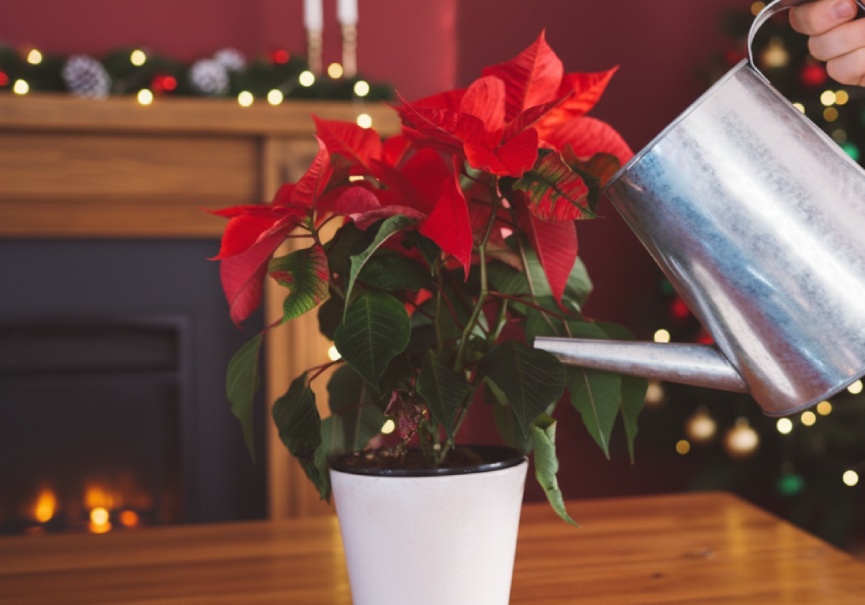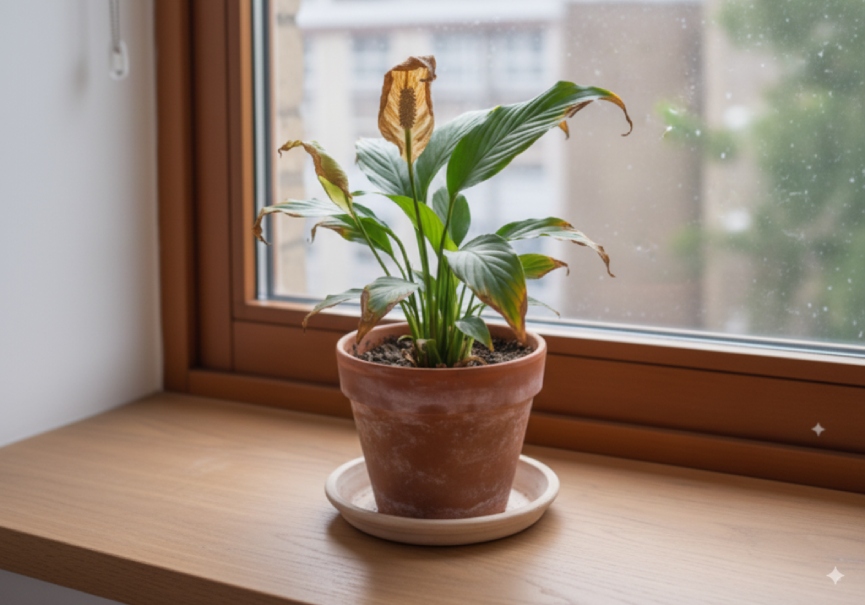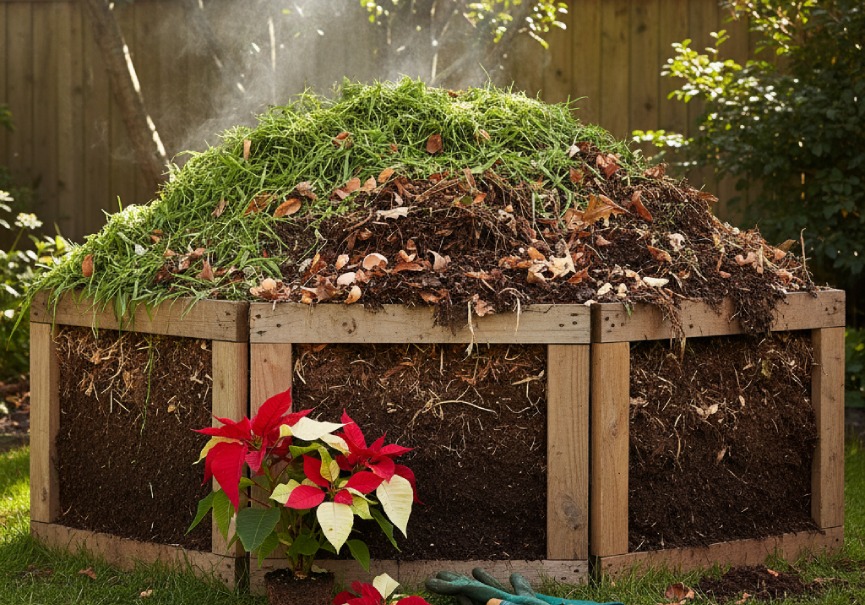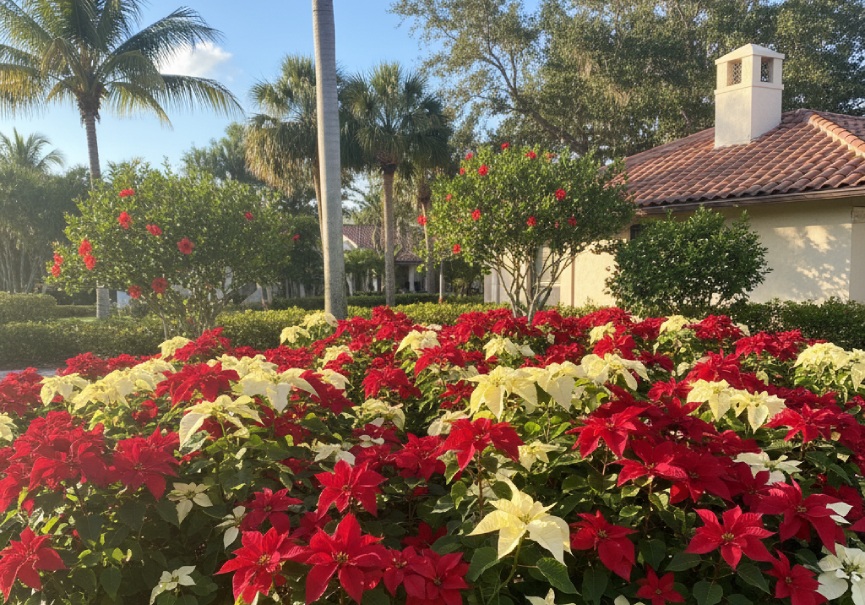Are you supposed to water Poinsettias?

Introduction: Unveiling the Truth About Poinsettias and Watering
As the holiday time gets closer, poinsettia plants with their red and green colors start showing up in homes and businesses. These plants are famous for making us feel happy during the holidays and reminding us of warmth and celebrations. When we put these plants in our decorations, we often wonder how to take care of them. One common question is: “How much water do poinsettias need or are you supposed to water poinsettias?” Poinsettias look so pretty with their colorful leaves, and we might think they need special care because of that. Taking care of poinsettias has different parts, and one part that confuses many people is about giving them the right amount of water. Should you give them lots of water or just a little? Is it okay to water them from the top, or should you water the soil? The answers are not as easy as they seem. In this article, we’re going to explain how to water poinsettias simply. We’ll talk about the parts of these special plants, figure out what makes them need water, and clear up some wrong ideas people might have about taking care of them. Whether you’re someone who’s good at gardening or you’re new to taking care of plants like these, let’s explore the world of poinsettias together and find out the truth about how much water they need. When you’re done reading, you’ll know how to take care of your poinsettias confidently, so they stay healthy not only during the holidays but also after.
Poinsettias: A Seasonal Symbol
Part of Our Traditions and way of life
Poinsettias are unique plants with a long history related to the holidays. They arrive from Mexico and had been named after Joel Poinsett, who became the first U.S. ambassador to Mexico. Those plants are actually connected to holiday decorations. They may be put in houses, offices, and public locations, and their colourful red and green leaves represent warmth, love, and the idea of giving. At the same time as we find out about how to take care of poinsettias, it’s vital to realize that these plants are simply crucial to our holiday customs and traditions.
Poinsettia Anatomy and Watering Needs
Getting to Know How the Plant is Built
To take good care of poinsettias, it’s super important to understand how they’re made. Poinsettias have roots, leaves, and colorful bracts. Each part has a big job in getting water and staying healthy. Learning about these parts helps us see how they use water to stay happy during the holidays.
What Roots, Leaves, and Bracts Do
Looking closely at poinsettia roots, leaves, and bracts shows us what makes them special when it comes to water. Roots are like straws that take water from the ground. Leaves and bracts help the plant lose some water through a process called transpiration. This keeps the plant’s moisture level just right. Knowing how these parts work together helps us know when to water.
Things that Affect Water Needs
A bunch of things make poinsettias need different amounts of water. Like how humid or hot it is around them, what kind of dirt they’re in, how big they are, how much they’re growing, and even how much sunlight they get. When we understand how these things affect water, we can give our poinsettias the perfect amount of water they need.
The Importance of Proper Watering in Poinsettias
Poinsettias are those colorful plants you often see around the holidays with red and green leaves. They need special care to stay healthy and look nice. One important thing to do is water them the right way. Let’s look at some simple tips:
1. Balance Water: Like other plants, poinsettias like water, but not too much or too little. Too much water can make the roots sick, and too little water can make the leaves droop. So, it’s important to find the right amount of water to keep the roots happy.
2. Good Soil and Draining: Poinsettias like soil that isn’t too wet. Using soil that lets water flow through and having a pot with holes at the bottom is good. This way, water won’t stay at the bottom and make the roots wet all the time.
3. When to Water: Poinsettias usually need water when the top part of the soil feels dry when you touch it. How often you water them depends on how warm it is and how big the pot is. When you water, make sure to pour enough water so it goes down to the roots.
4. Right Water: Poinsettias like water that is not too basic or too acidic. If your tap water is too basic, you might want to use special water or rainwater.
5. Don’t Wet the Leaves: Poinsettias have these pretty, colorful parts called bracts. Water on these parts can make them look not so nice. So, when you water, make sure to pour water near the soil and not on the leaves.
6. Look for Signs: Poinsettias can show you if they need water. If the leaves look sad or the bracts start to droop, it might mean they need more water. But if the leaves turn yellow, it could mean they’re getting too much water.
Making sure you water your poinsettias just right is super important. If you find the perfect balance between giving them enough water and not too much, using good soil and a well-draining pot, and paying attention to their signs, you’ll have beautiful poinsettias that stay healthy and happy, even after the holidays are over. Just remember, every home is different, so make small changes to your watering routine to make sure your poinsettias get what they need.
Signs of Overwatering and Underwatering in Poinsettias
Poinsettias, known for their striking red and green foliage, require precise care to maintain their beauty and health. One of the most common mistakes in caring for poinsettias is improper watering. Understanding the signs of overwatering and underwatering is essential for ensuring the well-being of these holiday favorites.
Signs of Overwatering:
1. Wilting and Yellowing Leaves: Ironically, overwatering can lead to wilting leaves. When the roots are constantly saturated, they struggle to absorb oxygen, causing the leaves to droop and turn yellow.
2. Leaf Drop: Overwatered poinsettias might shed their leaves excessively. As the roots suffocate due to excess moisture, the plant sheds leaves to reduce water loss through transpiration.
3. Mold or Mildew Growth: Excessive moisture encourages the growth of mold, mildew, and fungi. If you notice fuzzy white spots or a musty smell around the base of the plant, it’s a clear sign of overwatering.
4. Slowed Growth: Overwatering can hinder root development, leading to stunted growth. If your poinsettia isn’t growing as expected and its leaves appear healthy but small, overwatering could be the culprit.
5. Foul Odor: An unpleasant, rotten smell coming from the soil or the plant’s base is a strong indicator of root rot caused by excessive moisture.
Signs of Underwatering:
1. Wilting and Drooping: Just like overwatering, underwatering can also lead to wilting. The plant loses turgidity when there’s not enough water reaching its cells.
2. Crispy, Brown Leaf Edges: Insufficient water causes the leaf edges to become dry and brown. This is often a telltale sign of underwatering.
3. Leaf Curling: Poinsettias respond to water stress by curling their leaves. If the leaves appear wilted but are still green and curling inward, the plant is likely not receiving enough water.
4. Brittle Leaves: Leaves that feel brittle or papery to the touch are indicative of water deficiency. They lose their natural suppleness and become more fragile.
5. Soil Pulling Away from the Pot Edges: When soil dries out completely, it can contract and pull away from the sides of the pot. If you notice a gap between the soil and the pot, it’s a sign that the plant needs water.
6. Slow Recovery After Watering: If your poinsettia remains wilted even after watering, it might have undergone severe stress due to prolonged water scarcity.
Understanding these signs is essential for adjusting your watering routine to the specific needs of your poinsettias. Regularly monitor the plant’s condition and the moisture level of the soil to ensure that you’re providing the right amount of water. Remember that poinsettias thrive when there’s a delicate balance between hydration and allowing the roots to access oxygen. By fine-tuning your watering habits, you can enjoy vibrant and healthy poinsettias that enhance the festive atmosphere of your home.
Watering Frequency in Poinsettias: Finding the Right Balance
Watering frequency is a crucial aspect of poinsettia care that directly impacts the plant’s health, appearance, and longevity. Poinsettias, known for their vibrant red and green foliage, require a delicate balance when it comes to watering. Understanding the factors that influence watering frequency and tailoring your approach accordingly can help you maintain thriving and beautiful poinsettias.
Factors Influencing Watering Frequency:
1. Environmental Conditions: The temperature, humidity, and sunlight exposure in your environment play a significant role in determining how often your poinsettias need water. Warmer and drier conditions can cause the plant to lose moisture more rapidly, necessitating more frequent watering.
2. Pot Size and Material: The size of the pot and the type of material it’s made from influence the moisture retention capacity of the soil. Smaller pots and those made of materials like clay tend to dry out faster, requiring more frequent watering.
3. Soil Type and Drainage: Well-draining soil allows excess water to escape, preventing waterlogging and root rot. The type of soil you use can affect how often you need to water. Sandy soils dry out more quickly, while heavier soils retain moisture for longer periods.
4. Plant Growth Stage: Poinsettias have varying water needs during different growth stages. They often require more water during active growth and flowering, and less during periods of dormancy.
5. Root Development: Established root systems can access water more effectively than young, developing roots. Newly potted poinsettias may need more frequent watering until their root systems are well-established.
Guidelines for Watering Frequency:
1. Check the Soil: Before watering, always check the moisture level of the soil. Stick your finger about an inch deep into the soil. If it feels dry at this depth, it’s usually a good time to water.
2. Avoid Constant Moisture: Poinsettias prefer to dry out slightly between waterings. Overly soggy soil can lead to root rot, so ensure that the top inch or so of the soil has dried out before watering again.
3. Observe the Plant: Pay attention to how the plant responds to watering. Wilting, drooping leaves, and dry soil are signs of underwatering. If the leaves become yellow and the soil is constantly damp, it might indicate overwatering.
4. Water deeply: When you water, ensure that the entire root ball receives moisture. Water the plant until you see water starting to drain out from the bottom of the pot.
5. Adapt to Seasons: Adjust your watering frequency based on the changing seasons. Poinsettias may require less water during the winter months when their growth slows down.
6. Use Saucers Carefully: If using saucers under your pots, be mindful of not allowing the plant to sit in standing water, as this can lead to root problems.
Finding the right watering frequency for your poinsettias might require a bit of trial and error as you consider the unique conditions in your home. By understanding the plant’s water needs and closely monitoring its response, you can strike the ideal balance between providing enough moisture for its well-being while avoiding the pitfalls of overwatering.
Choosing the Right Pot and Soil for Poinsettias: A Recipe for Success
Selecting the appropriate pot and soil for your poinsettias is a critical step in ensuring their health, growth, and overall vibrancy. These iconic holiday plants require specific conditions to thrive, and understanding the role that pots and soil play can make a significant difference in their care.
Choosing the Right Pot:
1. Size Matters: Poinsettias don’t like to be too confined, but they also shouldn’t be in a pot that’s excessively large. Choose a pot that provides enough room for the root system to grow but not so much that it retains too much moisture. Generally, a pot about 1 to 2 inches larger in diameter than the root ball is suitable.
2. Drainage Holes: Poinsettias are highly sensitive to overwatering, so a pot with drainage holes is essential. These holes allow excess water to escape, preventing waterlogged soil and root rot.
3. Material: Clay pots allow for better breathability and moisture evaporation, but they can also dry out faster. Plastic pots retain moisture better but may require more careful monitoring to avoid overwatering. Choose a pot material that suits your local conditions and watering habits.
Choosing the Right Soil:
1. Well-Draining Mix: Poinsettias thrive in well-draining soil that allows excess water to escape easily. Use a high-quality, commercial potting mix formulated for indoor plants or a mix specifically designed for poinsettias.
2. pH Level: Poinsettias prefer slightly acidic to neutral soil (pH around 6.0 to 7.0). Check the pH of the soil mix before planting or adjust it if needed to create an ideal environment for nutrient absorption.
3. Aeration and Structure: The soil should have good aeration to allow oxygen to reach the roots. Look for mixes that contain ingredients like perlite or vermiculite, which help improve soil structure and drainage.
4. Nutrient Content: While poinsettias don’t require overly rich soil, it’s still important to provide them with a balanced mix that includes essential nutrients. Some potting mixes come enriched with slow-release fertilizers, which can be beneficial for poinsettias during their active growth phases.
Potting Procedure:
1. Pre-Wet Soil: Before potting your poinsettia, moisten the soil mix slightly. This ensures that the plant starts off in a moist environment.
2. Gently Remove from Nursery Pot: When transplanting from a nursery pot, be gentle to avoid damaging the roots. Support the plant’s base as you tip the pot to ease out the root ball.
3. Center the Plant: Place the poinsettia in the center of the new pot, making sure it’s at the same depth as it was in the nursery pot. Fill the pot with soil around the root ball.
4. Water and Settle Soil: After potting, water the plant thoroughly to help settle the soil around the roots. This also helps eliminate air pockets that might have formed during transplanting.
By choosing the right pot and soil, you’re creating a solid foundation for your poinsettias to flourish. The right conditions ensure that the plant’s roots can access oxygen and nutrients while preventing the risk of overwatering. Always consider your specific environmental conditions and the needs of the poinsettias when making these choices. With proper potting and soil care, you’ll be well on your way to enjoying healthy and stunning poinsettias throughout the holiday season and beyond.
Temperature and Humidity Considerations for Poinsettias: Creating the Ideal Environment:
Creating the right temperature and humidity conditions is crucial for the health and well-being of poinsettias, those iconic holiday plants known for their vibrant red and green foliage. These plants are native to Mexico and have specific preferences when it comes to their growing environment. Understanding the impact of temperature and humidity and how to provide the optimal conditions will contribute to the success of your poinsettias.
Temperature Requirements:
1. Avoid Cold Drafts: Poinsettias are sensitive to cold drafts. Keep them away from windows, doors, and areas where cold air can enter. Exposure to chilly temperatures, especially below 50°F (10°C), can cause leaf drop and stress the plant.
2. Optimal Range: Poinsettias prefer a temperature range of 65-75°F (18-24°C) during the day and slightly cooler temperatures at night. Avoid extreme temperature fluctuations, as they can negatively impact the plant’s health.
3. Protect During Transport: If you’re bringing home a poinsettia during colder months, make sure to shield it from low temperatures during transportation. Cover the plant with a bag or wrap it to prevent exposure to cold air.
4. Avoid Heating Vents: Placing poinsettias near heating vents or radiators can lead to rapid moisture loss and stress the plant. Maintain a comfortable and consistent temperature to keep your poinsettias happy.
Humidity Considerations:
1. Increase Humidity: Poinsettias are native to regions with higher humidity levels, so they appreciate slightly elevated humidity. Indoor environments, especially during the winter when heating systems are active, can become quite dry. Using humidifiers or placing the plant on trays with water and pebbles can help maintain adequate humidity levels.
2. Mist Sparingly: While misting can temporarily increase humidity, excessive misting can lead to fungal issues, especially if the plant’s foliage remains damp for extended periods. If you choose to mist, do so sparingly and avoid wetting the bracts.
3. Grouping Plants: Placing multiple plants together can create a microclimate with higher humidity levels, benefiting all the plants in the vicinity.
4. Avoid Overcrowding: While grouping plants can help with humidity, avoid overcrowding them, as this can impede air circulation and create conditions favorable for diseases.
Adjusting for Seasonal Changes:
1. Winter Care: During the colder months, when indoor heating systems are active, humidity levels can drop significantly. Maintain humidity through the methods mentioned earlier to counteract the drying effects of heating.
2. Summer Care: During the summer, when outdoor temperatures rise, poinsettias can benefit from being placed in a shaded area with good air circulation. Avoid direct sun exposure during the hottest parts of the day.
By paying close attention to temperature and humidity, you’re providing your poinsettias with an environment that closely mimics their natural habitat. These factors significantly influence the plant’s overall health, growth, and ability to resist pests and diseases. By striking the right balance and adjusting conditions based on the season, you can ensure that your poinsettias thrive and grace your holiday décor with their vibrant colors and lush foliage.
Fertilization and Its Impact on Watering: Nourishing Poinsettias for Health and Beauty:
Fertilization and watering are closely linked in the care of poinsettias, those iconic holiday plants known for their vivid red and green leaves. Providing the right nutrients in the correct balance has a direct impact on the plant’s overall health and growth, which in turn affects its water needs. Understanding how fertilization and watering are interconnected is essential for maintaining thriving and vibrant poinsettias.
Impact on Watering:
1. Balancing Nutrients and Water: Fertilization increases nutrient availability in the soil, which can impact the plant’s water requirements. Nutrient-rich soil tends to retain moisture more effectively, potentially reducing the frequency of watering.
2. Increased Growth: Proper fertilization encourages healthy growth and vibrant foliage. Lush growth can lead to a larger root system, which in turn requires more water. Be prepared to adjust your watering routine to accommodate the increased water demand as the plant grows.
3. Nutrient Uptake and Water Absorption: Adequate nutrients support the development of a strong root system, enabling efficient water absorption. A well-established root system can help the plant access water more effectively, reducing the risk of overwatering.
4. Observation and Adjustment: As you fertilize your poinsettias, closely monitor how the plant responds. If you notice faster growth or a change in water needs, adjust your watering schedule accordingly.
Balancing Act:
Finding the right balance between fertilization and watering is essential. Overfertilization can lead to salt buildup in the soil, which can affect water absorption and cause root damage. On the other hand, nutrient deficiencies can lead to stunted growth and poor health, impacting the plant’s ability to take up water properly.
Regularly assess the condition of your poinsettias, considering factors like growth rate, leaf color, and soil moisture. Adjust your fertilization and watering practices based on your observations. By providing the right nutrients and maintaining proper watering habits, you can enjoy vibrant, healthy poinsettias that enhance the festive atmosphere of your home.
Pruning and Its Relation to Watering: Shaping Healthy Poinsettias
Trimming, or pruning, is a helpful way to take care of poinsettia plants, which are those pretty plants with colorful leaves you see around holidays. When you trim a plant, you’re not just making it look nice it can affect how much water it needs too. Let’s see how pruning and watering are connected:
How Trimming Affects Watering:
1. Less Water Loss: When you trim a plant, you’re taking away some of its leaves. Leaves lose water through a process called transpiration. With fewer leaves, the poinsettia might not need as much water.
2. Balanced Water Use: Trimming helps the plant find the right balance between its leaves and roots. This balance makes the plant use water more evenly, which can prevent giving it too much water.
3. Watching and Changing: After you trim the plant, see how it acts. Because there are fewer leaves, it might not need as much water. You can adjust how often you water it based on how it looks.
Finding the Right Balance:
Trimming and watering go together to keep the plant healthy. Cutting too much can make the plant weak, and not cutting at all can make it grow too wild. If you trim just right and give it water when needed, your poinsettia will be colorful and healthy.
Pay attention to how your poinsettia looks whether its leaves are big or small, and if it looks thirsty or not. By knowing how trimming affects how much water it wants, you can take care of your poinsettia in the best way. This will help it stay both beautiful and strong.
Conclusion
Proper watering is a fundamental aspect of poinsettia care. By understanding the plant’s moisture requirements and following the guidelines provided, you can ensure your poinsettias stay vibrant and beautiful throughout the holiday season and beyond.
FAQ
1. Can I water poinsettias from the top? Ans:- Yes, you can water poinsettias from the top, but it’s best to water at the base of the plant to prevent water on the foliage.
2. How often should I water my poinsettia during the holidays? Ans:- Water when the top inch of soil feels dry. This might be every few days, depending on factors like temperature and humidity.
3. Should I mist my poinsettia’s leaves? Ans:- Misting isn’t necessary. Poinsettias prefer to be watered at the root level.
4. Can I use tap water for poinsettias? Ans:- Yes, tap water is generally fine, but allow it to sit for a day before using to allow chlorine to dissipate.
5. Should I fertilize my poinsettia while watering? Ans:- During the holiday season, fertilizing is generally unnecessary. Resume fertilizing after the plant’s growth picks up again.






